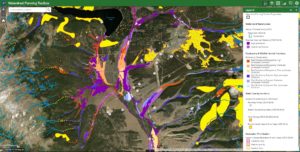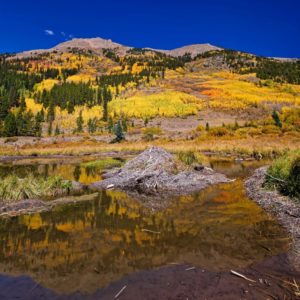The Colorado Wetlands Information Center has relaunched with new tools for wetlands mapping, and resources for understanding wetland types and their management for users. Managed by the Colorado Natural Heritage program, the digital clearinghouse of information and data provides user-friendly resources about all things related to Colorado’s wetlands and their ecology.
Wetland types, wetland ecology, and mapping tools for everyone
 Visitors can find information about different types of wetlands in Colorado, wetland conditions and information on wetland conservation and management. New with this release is a set of interactive mapping tools combining data on the location, extent, and condition of wetlands with other map layers like water quality and land management data. Feedback from both experts and lay people informed the development of mapping tools so that anyone can use them with ease, regardless of their background or expertise. CNHP has also created an entire series of web pages on Working in Wetlands, from restoration resources to a growing library of best management practices to give land owners and managers resources to understand and manage wetlands.
Visitors can find information about different types of wetlands in Colorado, wetland conditions and information on wetland conservation and management. New with this release is a set of interactive mapping tools combining data on the location, extent, and condition of wetlands with other map layers like water quality and land management data. Feedback from both experts and lay people informed the development of mapping tools so that anyone can use them with ease, regardless of their background or expertise. CNHP has also created an entire series of web pages on Working in Wetlands, from restoration resources to a growing library of best management practices to give land owners and managers resources to understand and manage wetlands.
“We hope that the new website and tools will inspire users to learn more, and care more about the complexity and value of Colorado’s wetlands”, said CNHP Ecohydrologist Sarah Marshall. “Compiling so many rich data sources and making the site more accessible and intuitive for users is really helping showcase Colorado’s incredible wetlands, and how they can be incorporated into statewide water, climate change, and conservation planning efforts.”
Wetlands are vital to Colorado
Incredible, and extremely important. According to the site, even though wetlands and riparian areas cover less than 3% of the state, they are among the most ecologically and economically important ecosystems in Colorado. Wetlands provide a wide array of natural goods and services, including sediment capture and retention, temperature regulation, flood attenuation, streamflow maintenance, carbon sequestration, metal removal and storage and more. Wetlands are also significant reservoirs of biodiversity, hosting a diverse array of plant and animal species, some of which are rare and endangered.
 The site is aimed at anyone interested in wetlands, from natural resource managers and landowners hoping to manage wetlands on their properties, to school teachers hoping to bring wetlands into their classroom curriculum. The site has already been useful in a variety of community planning efforts including Envision Chaffee County.
The site is aimed at anyone interested in wetlands, from natural resource managers and landowners hoping to manage wetlands on their properties, to school teachers hoping to bring wetlands into their classroom curriculum. The site has already been useful in a variety of community planning efforts including Envision Chaffee County.
“The CNHP Wetland Information Center provided an essential resource supporting multiple Envision programs – from prioritizing ranch lands for conservation, to managing the impacts of rapid recreation growth and even planning for community fire resilience, this is an exceptional tool,” explained CindyWilliams, Co-Lead of the Envision project.
The site is also informing prioritization exercises the Arkansas Headwaters Wetland Focus Area Committee is undertaking as well as the Colorado Wetland Program Plan, an EPA funded effort to establish a set of goals, objectives, and actions to conserve and restore Colorado wetlands over the next five years.
Wetland resources for a variety of needs
”The new CWIC will be regularly updated as new wetland resources become available,” said CNHP Wetland Ecologist Joanna Lemly. “There is a dual need for this information now. Federal policy on wetlands is changing, and, at the same time, scientific research has identified the important role wetlands play in providing clean, abundant water and buffering the impacts of climate change. We wanted to build a hub of information to help raise the awareness about Colorado’s valuable wetlands!”
Visit the Colorado Wetland Information Center at: https://cnhp.colostate.edu/cwic/
Since 1979, the Colorado Natural Heritage Programin CSU’s Warner College of Natural Resourceshas served as Colorado’s only comprehensive source of information on the status and location of Colorado’s rarest and most threatened species and plant communities.